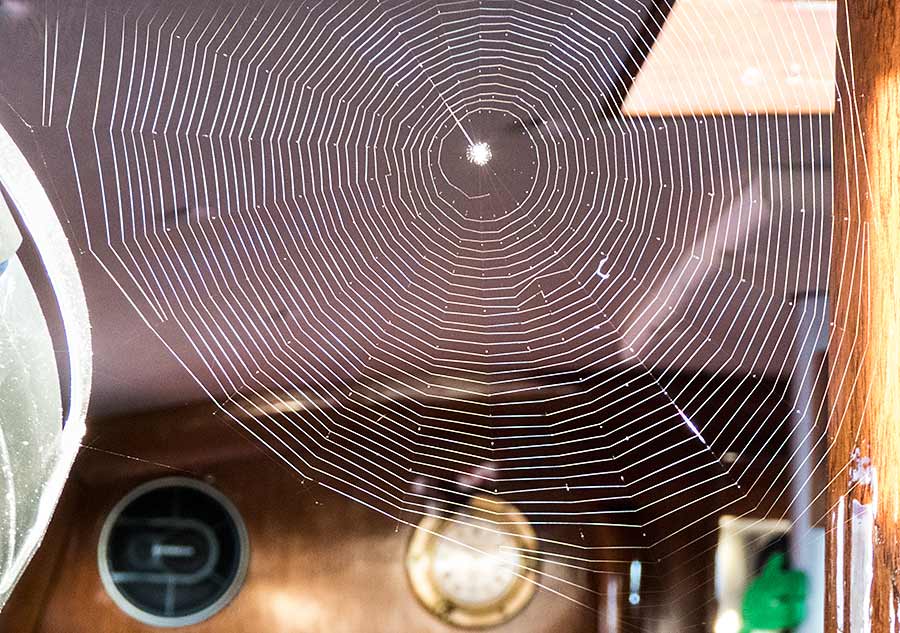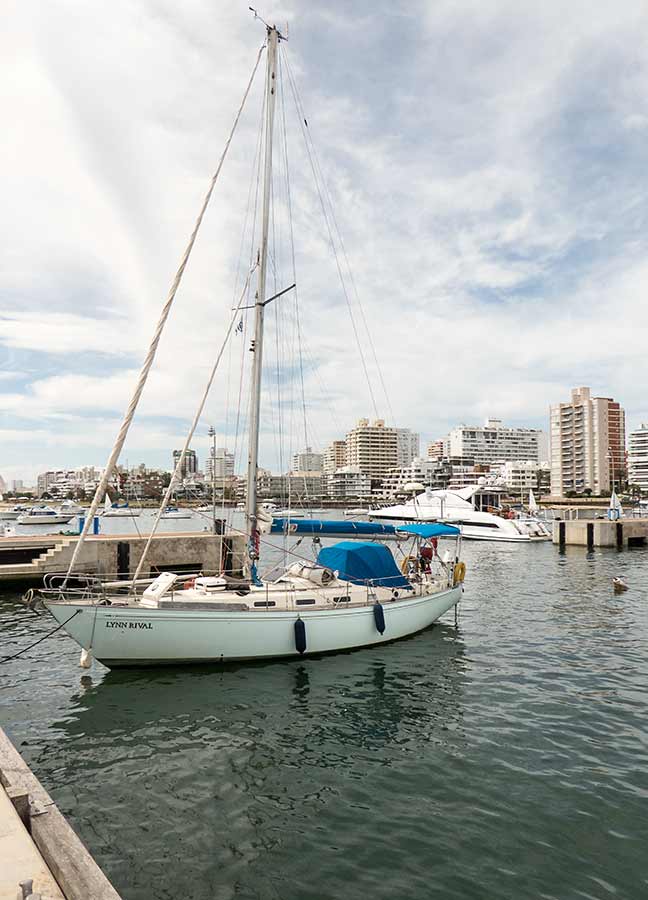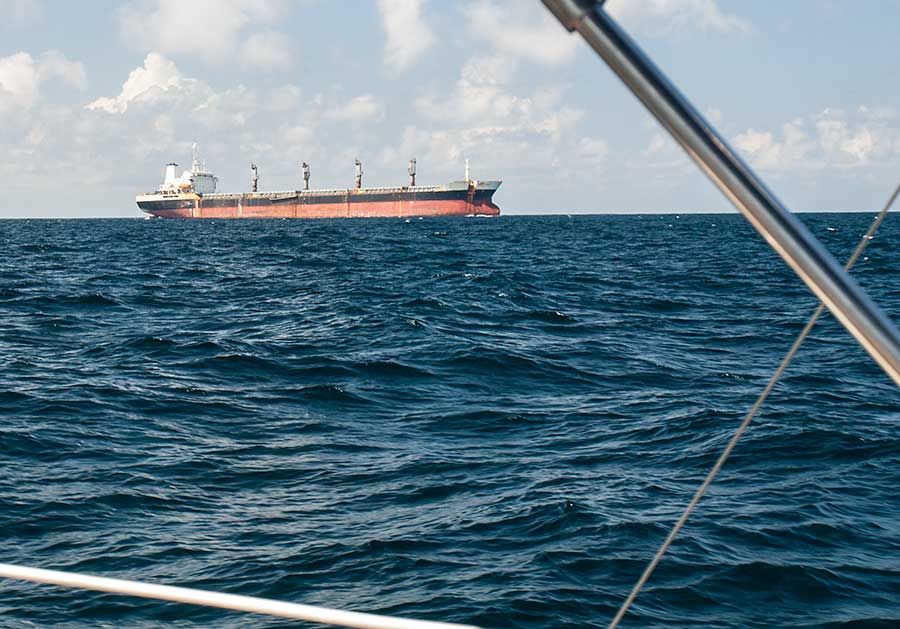The sea lion coast - and a few whales

Mystic of Holyhead (successor to Lynn Rival)
Rachel and Paul Chandler
Thu 19 Mar 2015 21:53
|
32:01.52S 052:06.36W As the days passed by in Puerto Sauce we realised that there would never been an ideal forecast so we settled on the next least adverse-looking weather window due on the 12th. By then we had had enough of getting ready and just wanted to get going. Apart from an increasing population of resident spiders - who were covering us in cobwebs - one problem was what to do with our bicycles. They had been so useful for getting around Juan Lacaze but we really don't have room for them on board. And even if we dismantled them and filled up the fo'c's'le with the bits, we couldn't envisage when we'd be able to use them again, so rarely do we tie up to a quay. In the last week a couple of new arrivals appeared - including a yacht from Spain, skippered by Carlos who spoke excellent English - and he now has our wheels.  Most of the stowaways wove their webs outside, but some ventured inside Leaving Puerto Sauce was also quite an expensive process. The Prefectura insisted we pay a tax of about US$650 (based on gross registered tonnage) before they would give us permission to leave. We did know about this tax, payable after a vessel is kept in Uruguay for more than nine months, but we were not sure how strictly it was applied to sailing yachts. We know now. We left at dawn on Thursday 12th and had a northerly wind for most of the morning, making good speed towards Montevideo. In the afternoon the wind dropped so we motored for a couple of hours until it returned - at first gently from the southeast, then increasing - so for the rest of the day we were tacking to windward. By midnight we were off Montevideo, beating our way through the shipping lanes and anchorages, but the wind was backing so by the early hours we were fetching nicely for our destination, Punta del Este. Soon after dawn the wind dropped again and we ended up motoring past Piriapolis - now in clear blue-green sea water, no longer muddy river water - arriving at Punta by lunchtime. In our first sail for over a year we'd covered 147 miles in just over 30 hours - and most things worked.  Lynn Rival enjoying a rare marina moment - when the bill was presented we remembered why they are rare! Situated at the mouth of the River Plate Punta del Este is an ideal stopping-off place: a chance to check the weather forecast and, if necessary, wait before heading north. The southeasterly winds that make it difficult to get out of the River Plate would be welcome now. However along the east coast of Uruguay and southern Brazil the winds are usually from the north east with the occasional southerly, which can be quite strong. We went into the marina at Punta del Este (there is no option to anchor) - greeted by a sea lion splashing around - and found it three-quarters empty. They are still charging high season prices (until March 16) and those who can afford them have long gone. Paul nearly had a heart attack when we were told a berth would cost us £70 per night - plus charges for water, electricity and showers. We were expecting to get a 40% discount - applicable in other Uruguay harbours for long-term visitors to the country - but apparently it doesn't apply in high season here. Luckily the weather forecast was good for the following day so we only had to stay one night. Punta del Este is unlike anywhere else we've been in Uruguay: the self-styled 'most sophisticated tourist resort in South America' catering for all sorts, from the jet-set to visiting cruise ships. It must seem like another world to ordinary Uruguayans. We didn't have the time to discover whether it has any hidden charms other than the obvious beautiful beaches and good selection of restaurants. Our priorities were dealing with the authorities (immigration, customs and coastguard) - all conveniently close to the marina - and a supermarket for stocking up on fresh produce - also close by. On Saturday afternoon we set off out into the Atlantic Ocean proper. With light winds from the south we sailed and motor-sailed north east, up the Uruguayan coast, passing the port of La Paloma where we'd stopped on the way down. On Sunday we also passed by the isolated anchorage at Cape Polonia with it's large population of sea lions. Instead we put up the gennaker and made good progress towards the border with Brazil in moderate winds. At supper-time we saw a whale - presumably a humpback on it's way north for the winter.  AIS - who needs it? He did turn it on just as I took this pic. (about 3/4 mile away) In the early hours of Monday the wind dropped and we motored until mid-morning. Once again we saw whales passing close enough for their blowing noises to attract our attention. For the rest of the day, approaching the channel into Rio Grande, we were sailing downwind and continued to sail up the channel, past the main port. Finally, we had to take the sails down and use the motor to navigate the last few miles which involve a narrow channel and ferry traffic as we approached the town.  Thar she blows Rio Grande town is at the southeast end of a vast lagoon (Duck Lake) which extends northeast to the city of Porto Alegre some 125 miles away. Rio Grande is a large industrial port and the lagoon is a haven for wildlife. It's a strange mix. Entering the channel in the evening sun we saw sealions lounging on the breakwater, enjoying the warmth of the tetrapods and large, bottlenose dolphins fishing seemingly oblivious of the large ships coming and going. Further in birdlife - herons, egrets and all sorts - thrives on the east side of the channel while heavy industry - constructing wind turbines - thrives on the west.  It's a hard life - sunbathe or swim? It was dark by the time we approached the anchorage off the Oceanographic Museum - dodging the evening rush-hour of ferries coming and going from Rio Grande to the town of Sao Jose de Norte not far away on the other side of the lagoon - but having been here before we knew the layout. We dropped the hook and promptly had an arrival beer with a toast to Jill on her birthday - Uruguayan Patricia beer of course. We slept well and the next day pumped up the dinghy and rowed ashore. When we asked the Museum staff for permission to use their jetty they immediately invited us to bring Lynn Rival alongside with water and electricity, all free of charge. Welcome to Brazil! |